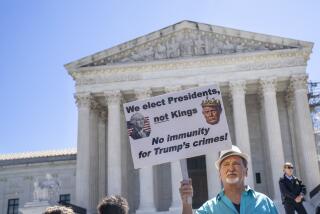The limits on liberty
Delegates to the Second Continental Congress signed the Declaration of Independence 236 years ago today, accusing King George III of trying to establish “an absolute Tyranny over these States.” The republic they went on to establish, however, continues to struggle with the tension between individual liberty and shared responsibility, and between the freedom of the governed and the obligations imposed by the government. This tension ebbs and flows over time as the prevailing political winds shift, administrations come and go, and the makeup of the judiciary changes. Nevertheless, concern about the reach and scope of the federal government is likely to be a central issue in this year’s elections, in part because of the Supreme Court ruling on President Obama’s healthcare law that, oddly enough, placed new limits on Congress’ power.
The framers themselves were split, with urban Federalists such as Alexander Hamilton favoring a strong central government, and their rural opponents, most notably Thomas Jefferson and James Madison, arguing that power should reside closer to the people. The compromise they struck in the Constitution was a federal government limited to specific “enumerated” powers, with the rest reserved for state and local governments and the people. Within those enumerated areas, the Constitution granted Congress broad authority to enact whatever laws were “necessary and proper,” and it set a relatively low bar -- a simple majority vote of both chambers -- for lawmakers to send a bill to the president.
Efforts to limit federal power were also reflected in the multiple checks and balances put in place by the framers and by the early Supreme Court. Nevertheless, the boundaries that the Constitution laid out aren’t entirely clear, nor are they rigid. Washington has long used its power to tax and spend to subsidize public schools, homeowners, police departments and a variety of other local interests. And the shift from an agricultural economy to an industrial one transformed commerce from a predominantly local activity to one characterized by national and global markets, exposing more businesses to the purview of federal regulators.
The spiritual descendants of Hamilton and Jefferson have squared off every few decades over the government’s reach, both in the courts and at the ballot box. Reconstruction, the Progressive Era crackdown on monopolies and robber barons, and the New Deal response to the Depression were all characterized by significant expansions of federal power, yet all were resisted to some degree by a skeptical Supreme Court.
Led by “tea party” adherents, today’s critics of governmental power have many complaints, but the most bitter concern the 2010 Patient Protection and Affordable Care Act. We have long supported the measure as an important step toward better quality, improved access and more affordability in healthcare, and we strongly disagree with critics who characterize it as a government takeover that ran roughshod over the Constitution. But even as the Supreme Court upheld much of the act last week, its five conservative justices called the law an overreach. They also laid out two never-before-seen limits on congressional authority.
In separate opinions, the conservatives agreed that Congress’ power to regulate interstate commerce does not let it compel people to enter markets in which they’re not active participants, such as the market for health insurance. Nor does Congress’ power of the purse enable it to force states to provide significant new services by threatening to withhold federal funding for other programs, the court ruled in blocking the bill’s mandatory expansion of Medicaid.
What Congress does have broad authority to do, conservative Chief Justice John G. Roberts Jr. and the court’s four liberals held, is impose taxes -- in this case, a tax (labeled a penalty) on adult Americans who do not obtain health insurance. One irony is that Obama and congressional Democrats took pains to characterize the requirement to carry insurance as a mandate, not a tax. Another is that Democrats didn’t really like the idea of mandating private coverage -- which originated in a Republican healthcare reform proposal from the 1990s -- but they didn’t have the votes for a politically controversial but constitutionally safer alternative that many liberals preferred: offering a Medicare-like government insurance program to all Americans.
Roberts presented the tax ruling as a proper act of deference by the court to the policy judgments made by the legislative branch -- a concession that elections matter. “It is not our job to protect the people from the consequences of their political choices,” he wrote. Conservative critics, naturally, called it a defeat for liberty and accused Roberts of ignoring the Constitution in the face of political pressure.
The decision won’t be the judiciary’s last word on the healthcare law; a group of Roman Catholic institutions has sued over the administration’s mandate to include contraception coverage in group policies, arguing that it violates their 1st Amendment right to religious freedom. But as Roberts’ opinion noted, the ultimate check on the power of Congress is at the ballot box. If enough Americans want to repeal the Affordable Care Act, they can do so by putting the law’s opponents in charge of Congress and the White House in November. Throwing out an incumbent for exerting too much power, after all, is the ultimate exercise in liberty.
More to Read
Sign up for Essential California
The most important California stories and recommendations in your inbox every morning.
You may occasionally receive promotional content from the Los Angeles Times.










